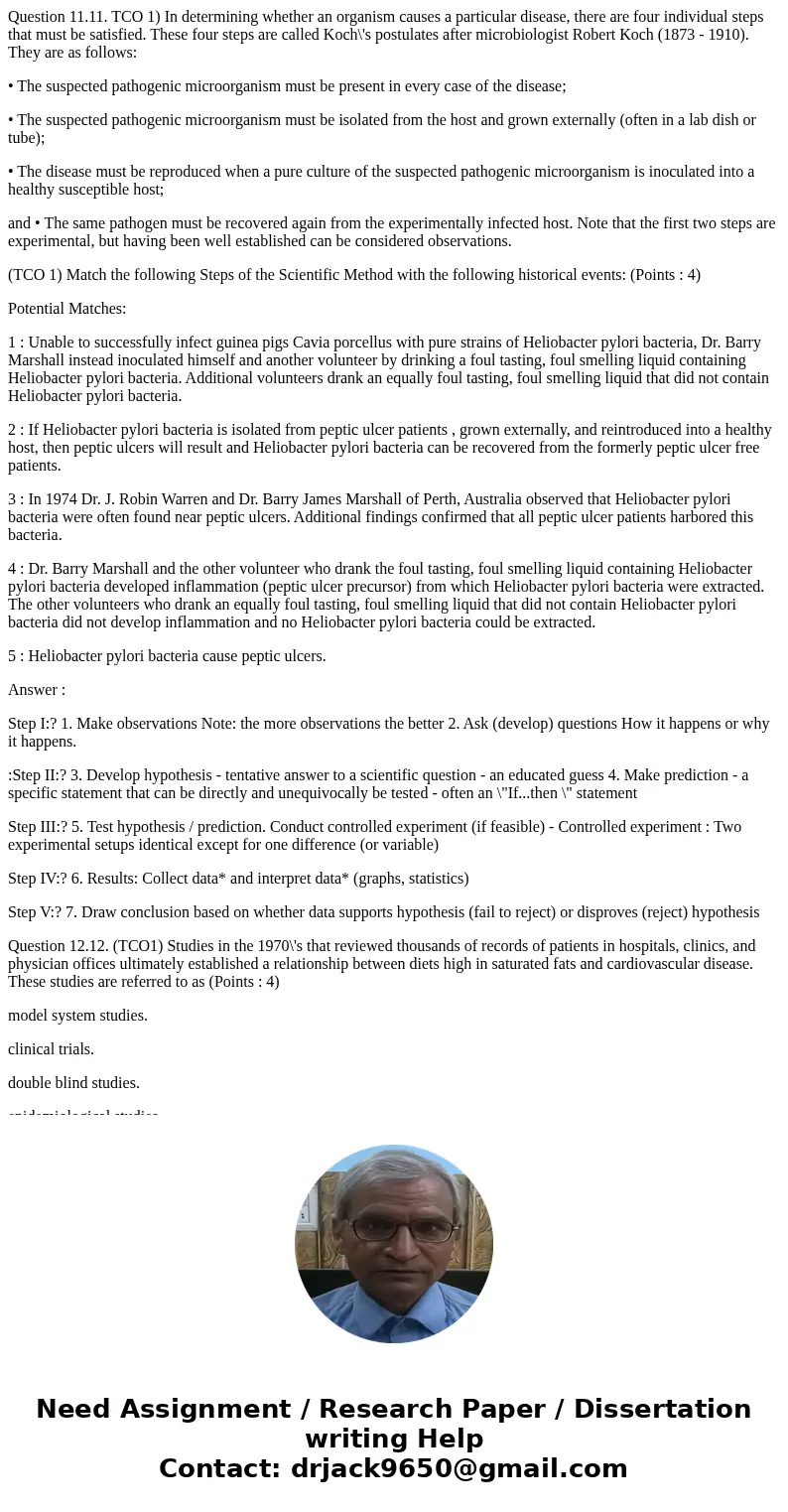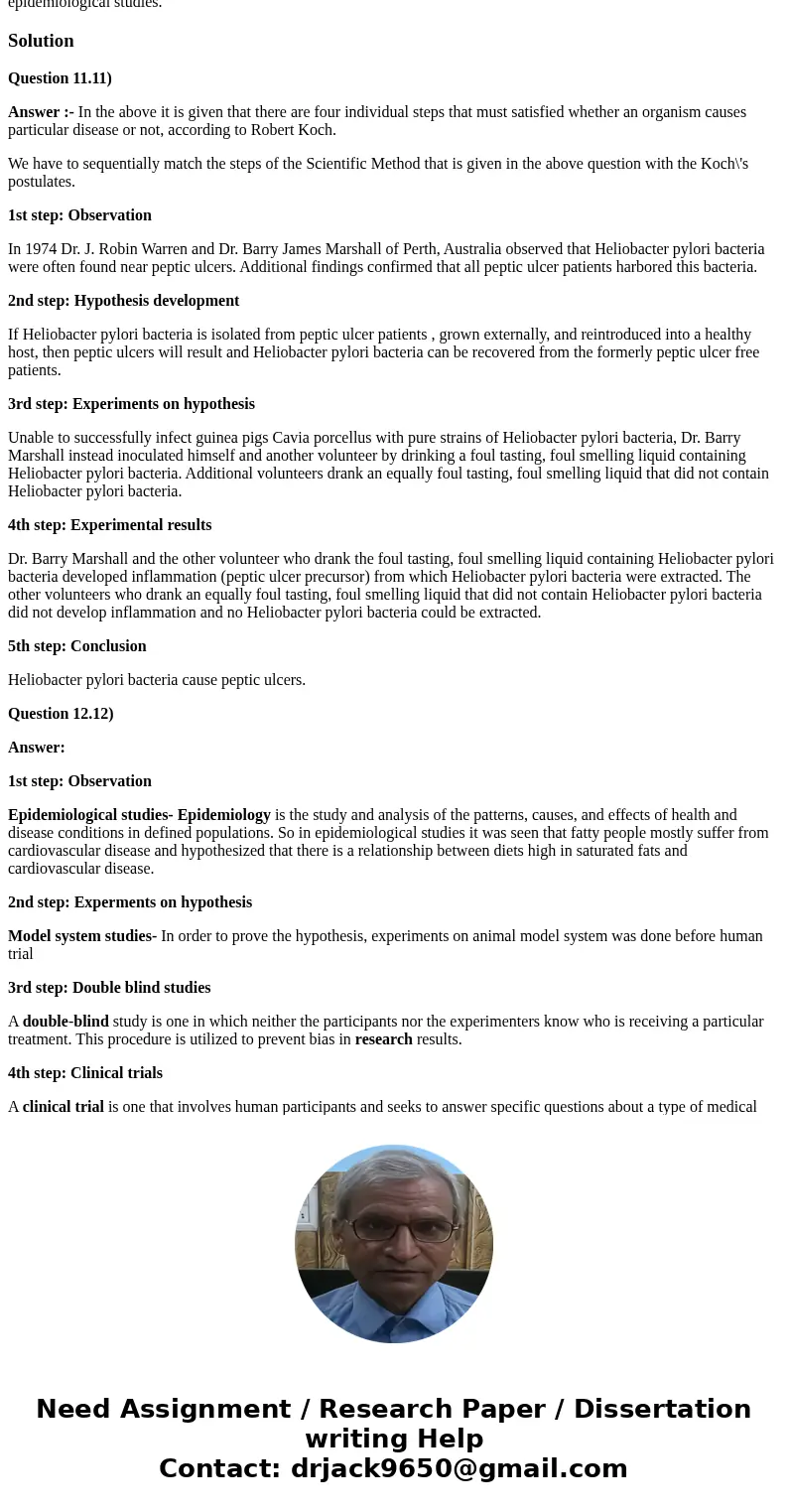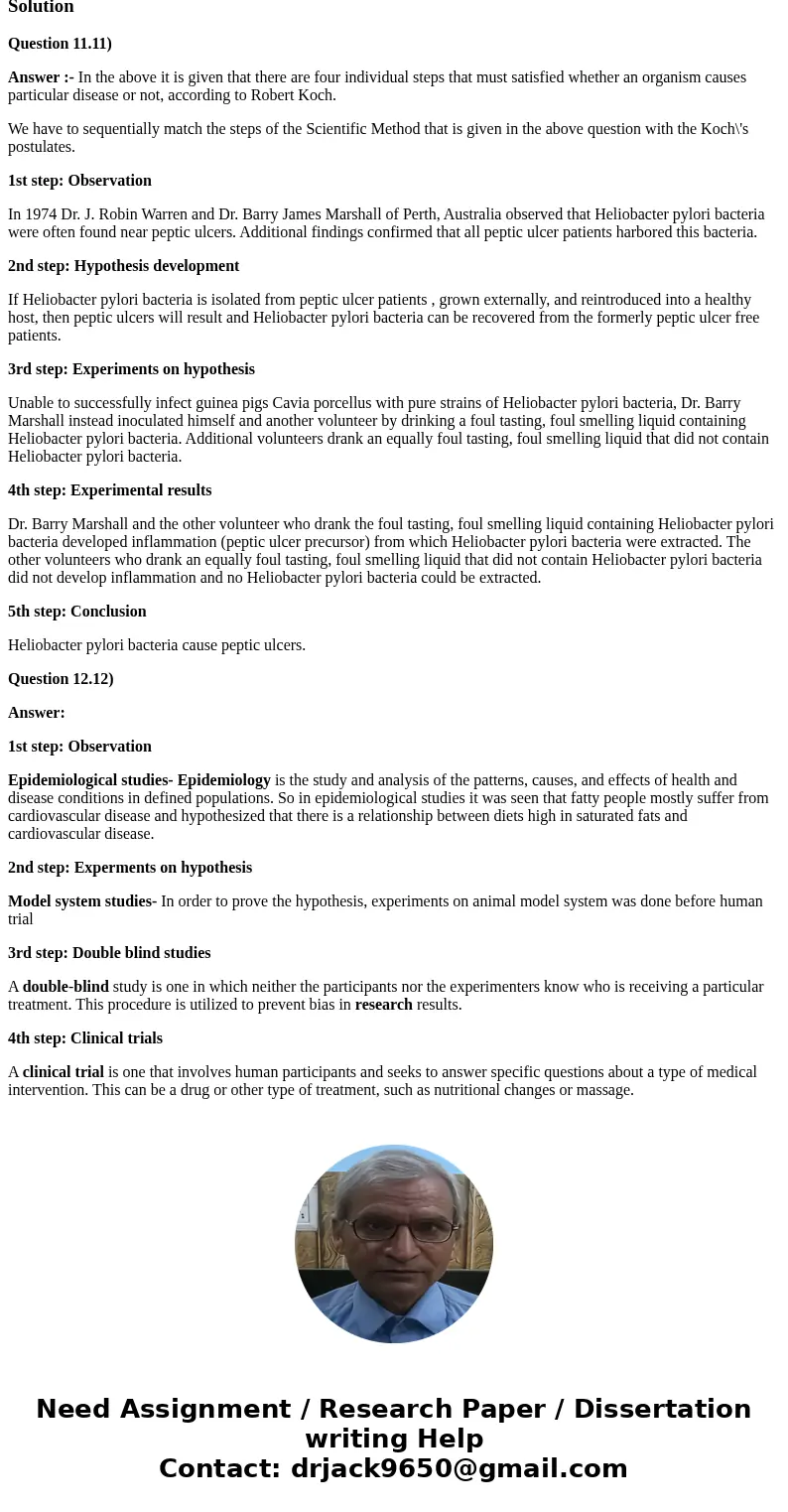Question 1111 TCO 1 In determining whether an organism cause
Question 11.11. TCO 1) In determining whether an organism causes a particular disease, there are four individual steps that must be satisfied. These four steps are called Koch\'s postulates after microbiologist Robert Koch (1873 - 1910). They are as follows:
• The suspected pathogenic microorganism must be present in every case of the disease;
• The suspected pathogenic microorganism must be isolated from the host and grown externally (often in a lab dish or tube);
• The disease must be reproduced when a pure culture of the suspected pathogenic microorganism is inoculated into a healthy susceptible host;
and • The same pathogen must be recovered again from the experimentally infected host. Note that the first two steps are experimental, but having been well established can be considered observations.
(TCO 1) Match the following Steps of the Scientific Method with the following historical events: (Points : 4)
Potential Matches:
1 : Unable to successfully infect guinea pigs Cavia porcellus with pure strains of Heliobacter pylori bacteria, Dr. Barry Marshall instead inoculated himself and another volunteer by drinking a foul tasting, foul smelling liquid containing Heliobacter pylori bacteria. Additional volunteers drank an equally foul tasting, foul smelling liquid that did not contain Heliobacter pylori bacteria.
2 : If Heliobacter pylori bacteria is isolated from peptic ulcer patients , grown externally, and reintroduced into a healthy host, then peptic ulcers will result and Heliobacter pylori bacteria can be recovered from the formerly peptic ulcer free patients.
3 : In 1974 Dr. J. Robin Warren and Dr. Barry James Marshall of Perth, Australia observed that Heliobacter pylori bacteria were often found near peptic ulcers. Additional findings confirmed that all peptic ulcer patients harbored this bacteria.
4 : Dr. Barry Marshall and the other volunteer who drank the foul tasting, foul smelling liquid containing Heliobacter pylori bacteria developed inflammation (peptic ulcer precursor) from which Heliobacter pylori bacteria were extracted. The other volunteers who drank an equally foul tasting, foul smelling liquid that did not contain Heliobacter pylori bacteria did not develop inflammation and no Heliobacter pylori bacteria could be extracted.
5 : Heliobacter pylori bacteria cause peptic ulcers.
Answer :
Step I:? 1. Make observations Note: the more observations the better 2. Ask (develop) questions How it happens or why it happens.
:Step II:? 3. Develop hypothesis - tentative answer to a scientific question - an educated guess 4. Make prediction - a specific statement that can be directly and unequivocally be tested - often an \"If...then \" statement
Step III:? 5. Test hypothesis / prediction. Conduct controlled experiment (if feasible) - Controlled experiment : Two experimental setups identical except for one difference (or variable)
Step IV:? 6. Results: Collect data* and interpret data* (graphs, statistics)
Step V:? 7. Draw conclusion based on whether data supports hypothesis (fail to reject) or disproves (reject) hypothesis
Question 12.12. (TCO1) Studies in the 1970\'s that reviewed thousands of records of patients in hospitals, clinics, and physician offices ultimately established a relationship between diets high in saturated fats and cardiovascular disease. These studies are referred to as (Points : 4)
model system studies.
clinical trials.
double blind studies.
epidemiological studies.
Solution
Question 11.11)
Answer :- In the above it is given that there are four individual steps that must satisfied whether an organism causes particular disease or not, according to Robert Koch.
We have to sequentially match the steps of the Scientific Method that is given in the above question with the Koch\'s postulates.
1st step: Observation
In 1974 Dr. J. Robin Warren and Dr. Barry James Marshall of Perth, Australia observed that Heliobacter pylori bacteria were often found near peptic ulcers. Additional findings confirmed that all peptic ulcer patients harbored this bacteria.
2nd step: Hypothesis development
If Heliobacter pylori bacteria is isolated from peptic ulcer patients , grown externally, and reintroduced into a healthy host, then peptic ulcers will result and Heliobacter pylori bacteria can be recovered from the formerly peptic ulcer free patients.
3rd step: Experiments on hypothesis
Unable to successfully infect guinea pigs Cavia porcellus with pure strains of Heliobacter pylori bacteria, Dr. Barry Marshall instead inoculated himself and another volunteer by drinking a foul tasting, foul smelling liquid containing Heliobacter pylori bacteria. Additional volunteers drank an equally foul tasting, foul smelling liquid that did not contain Heliobacter pylori bacteria.
4th step: Experimental results
Dr. Barry Marshall and the other volunteer who drank the foul tasting, foul smelling liquid containing Heliobacter pylori bacteria developed inflammation (peptic ulcer precursor) from which Heliobacter pylori bacteria were extracted. The other volunteers who drank an equally foul tasting, foul smelling liquid that did not contain Heliobacter pylori bacteria did not develop inflammation and no Heliobacter pylori bacteria could be extracted.
5th step: Conclusion
Heliobacter pylori bacteria cause peptic ulcers.
Question 12.12)
Answer:
1st step: Observation
Epidemiological studies- Epidemiology is the study and analysis of the patterns, causes, and effects of health and disease conditions in defined populations. So in epidemiological studies it was seen that fatty people mostly suffer from cardiovascular disease and hypothesized that there is a relationship between diets high in saturated fats and cardiovascular disease.
2nd step: Experments on hypothesis
Model system studies- In order to prove the hypothesis, experiments on animal model system was done before human trial
3rd step: Double blind studies
A double-blind study is one in which neither the participants nor the experimenters know who is receiving a particular treatment. This procedure is utilized to prevent bias in research results.
4th step: Clinical trials
A clinical trial is one that involves human participants and seeks to answer specific questions about a type of medical intervention. This can be a drug or other type of treatment, such as nutritional changes or massage.



 Homework Sourse
Homework Sourse